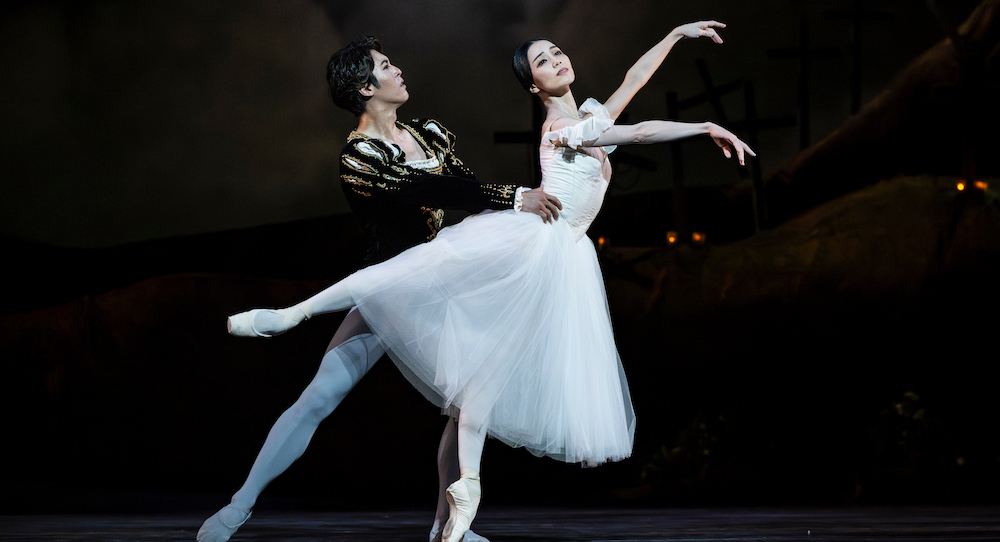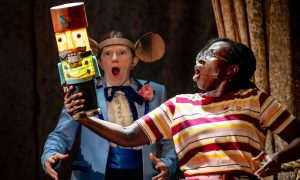Royal Opera House, London.
25 July 2025.
That spine-tingling moment, when the lights dim and the reverent hush sweeps over the audience – magical! The overture begins: We know the familiar music by Adolphe Adam, and we know the choreographic structure of the work by Marius Petipa, but it’s a first to experience The National Ballet of Japan on the Royal Opera House stage presenting the tragic 19th century ballet Giselle.
We know we’re in for a wonderful evening as the red curtains rise on the deep and lavish Opera House stage, and the expected busy village scene appears with so much detail.
Dick Bird has created a delightfully atmospheric set: wooden cottages on either side, smoke rising from the chimney of Giselle’s cottage and tall trees topped with the red, brown leaves of Autumn filling the background, with a pathway leading through them up and away off stage.
The awaited moment of Giselle’s entrance soon arrives, and Ayako Ono’s engaging light and expressive face and girlish skips as she steps from the cottage are met with applause. She is impressive on first sighting, and her impact continues to grow. The beginning of her romance with Prince Albrecht, danced by Yudai Fukuoka, shows him to be a little cooler in expression than she, but a very talented match they proved to be.
Act 1 of Giselle is always filled with joyous communal dancing, light and love, and these themes are so engaging here as we watch the weaving patterns of the folk dances, costumed in the same warm autumnal shades as the set.
Albrecht dances for Giselle, showing off his virtuosity and she, a picture of loving innocence, repeatedly kisses her hand and places it into his as she posés towards him. Full of life with effortless poise. The music darkens as Giselle’s mother firmly disapproves, however, due to Giselle’s health, and in spite of her reassurances, Giselle is ushered away home.
The royal visit to the village is rich and splendidly dressed. Quite a sight and so much to look at on stage. Giselle’s mother, danced by Misato Uchida bows before the Duke and provides refreshments. The music remains inquisitive as the villagers and royalty interact. Giselle dances for a poised but gracious Bathilde, and then it is time for the Peasant Pas de Deux. Kasumi Okuda and Yuki Kaminaka complement each other, matched in their relaxed presentation and travelling with such easy grace; they present Petipa’s choreography with assurance.
This merry atmosphere darkens when Hilarion, the woodsman, challenges Giselle with his discovery of the royal sword and horn that Albrecht has hidden. Yoshito Kinoshita is aggressive and sly in this role. There’s a dramatic moment when he blows the horn – silence on stage – and they hear the royal reply in the distance. Then Giselle knows that Albrecht is not the peasant boy he has made himself out to be.
The betrayal scene is emotionally portrayed by the whole company on stage. Giselle is surrounded by concerned villagers, frozen holding her head in her hands, the news sinking in. The orchestration is so cleverly moving as it echoes the playful scenes of their earlier ‘he loves me, he loves me not’ petal-plucking game.
Albrecht looks pained and guilty as Giselle, with hair loose, moves wildly through the crowd. She hugs her mother and slips through Albrecht’s arms, dead.
Act 2, heavier with a solemn beat of the drum, opens on a dark and desolate scene. Another incredible set design by Dick Bird. Woodland trees are on either side, banks covered in crosses marking graves and a deep orange glow from fairy lights illuminating them, while the moon is high in the sky on the backdrop. We will see it lower and disappear as the night continues and morning arrives.
Myrtha, danced by Yui Negishi is utterly mesmerising as she bourrées, floating ethereally, from one side of the stage to the other. The Wilis are equally as impressive in their ghostly graceful lines, chilling as they enter veiled from between the trees and graves, commanded by Myrtha.
It is a stunning line-up of motionless Wilis, wrists crossed and heads turned, who move into arabesque shunts, legs in perfectly held arabesques as they cross over their lines, with such exacting precision.
Giselle’s ghost is summoned. Her girlish charm has vanished, and she is almost a different dancer entirely in the absence of effervescent joy. Yet, Ono delivers a deeply sensitive performance sustained by sorrowful love for her prince, as she tries again and again to protect him from his fate of dancing to death. Too late for Hilarion, who was dragged over the edge of the cliff by the Wilis, Giselle is determined to shoulder the burden with Albrecht and dances with and for him throughout the night. He senses rather than sees her initially, and he reaches into the dark for her. In a touching moment of protection, she leans over his shoulder in an arabesque as he kneels.
In spite of Myrtha’s steely ruling, Albrecht does indeed survive until the break of dawn, signalled by the toll of a bell, which feels triumphant as the Wilis fade away, back into the shadows between the trees.
Until Giselle, too, melts away from Albrecht. The enormity of her death is overwhelming as he collapses over her grave.
Such stunning and captivating technical brilliance this evening. Hopefully there will be opportunity to see more of this company’s repertoire.
By Louise Ryrie of Dance Informa.








